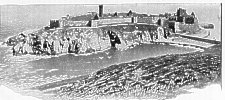The Firbolgs are reckoned amongst the first adventurers who colonised Ireland. Nennius, in his ” History of the Britons,” expressly declares that from Ireland they spread themselves to Man and other islands. Some writers have hesitated to refer his words to the Isle of Man, but the Latin text removes all doubt, for the phrase Eubonia Insula admits of only one interpretation, viz., ” The Isle of Man.” Ptolemy the Geographer, who wrote in the second century, places the Isle of Man among the Irish islands. A number of years later (A.D. 254) the migration of a colony of Irish Cruithneans from Ulster to Man is registered by Tighernach. Many of this tribe, however, chose to remain in Ireland and pay tribute to the King of Ulster, and we find them still there when St. Patrick came to our island. They continued to enjoy their own peculiar laws and customs, and were looked upon by the settlers in Man and Wales as still forming part of their common family.

St. Patrick’s Island, Peel – showing Oratory, Cathedral, and Pillar Tower
This being the actual condition of things, we can readily imagine how St. Patrick might have considered his mission incomplete had he left the Isle of Man unvisited. Accordingly we find that, with Ireland, Man shares the glory of having Patrick for its Apostle. In Wilson’s History* we are told that the ” Isle of Man was converted to the Christian faith by St. Patrick in the year 440.” So devoted were the Manx men in after ages to his memory, that the promontory now called Peel, formerly separated from Man, was in the Chronicon Manniae always called Insula Sancti Patritii, or St. Patrick’s island.* Manx Soc., vol. xviii., p 106,

